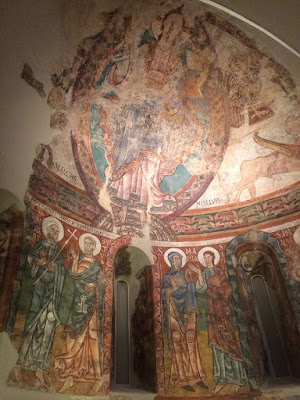One of the great pleasures of visiting Spain is that, despite the violence that has been visited on her churches and abbeys from time to time, by and large its ecclesiastical heritage has remained far more intact and organically preserved than the rest of Europe. Even Italy, which may not have had the Reformation, saw not a little damage at the hands of the counter-Reformation to its older ecclesiastical heritage. Thus, Spain’s cathedrals are often fascinating and surprisingly harmonious hodgepodges of Gothic architecture, Renaissance silver and ironwork and Baroque altarpieces, or any other combination of the above. For better or worse, though, its heritage of Romanesque painting can largely now only be seen in museums such as the Museo Nacional in Barcelona’s Parc de Montjuïc.
I was, admittedly, not at my best when I visited it about two years ago in the autumn. Tripping over a low bench in the dark of my hotel room had left me face-planted with a touch of rug burn and a rather extragant nosebleed, so I spent most of the rest of the trip with a rather arresting bruise on my face. However, I do remember the absolutely stupendous collection of Romanesque frescoes taken from all over Catalonia, many of them apses and whole church interiors. One might wish these remained in situ, but given the vagaries of history and renovation, perhaps they are safer here. I am no apologist of primitivism for its own sake—Picasso allegedly was inspired by some of these vast and occasionally weird images—but there is both a beautiful clarity of line and a moving otherworldliness to these stunning and simple, but never crude images. Admitted, there is also a bit which to the modern eye seems jumbled, preposterous or comic (the phrase "derpy kings" popped into my head at one point), but is easy to overlook these bits and concentrate on the static, almost Egyptian grandeur of these images, populated by vast and unmoving seraphim and distinctly un-Egyptian, whirling clouds of angels and winged Evangelical beasts and thick-outlined Pantocrators.
Even more exciting for the student of liturgy is their collection, interspersed with wooden altar frontals (some decorated with martyrdoms of an almost comic directness), the undersides of canopies, and even the remnants of a baldachin. It is all colorful and clear with the rich clarity of a manuscript illumination, and, while there is great charm in grey Gothic and greyer Romanesque, we ought to recall this esoteric riot of color and figures graced every church of Christendom until time or the tide of revolution washed it away.
Image may be NSFW.
Clik here to view.






